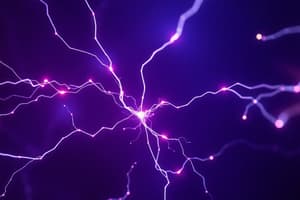Podcast
Questions and Answers
What happens when two glass rods, rubbed with wool, are brought close to each other?
What happens when two glass rods, rubbed with wool, are brought close to each other?
- They attract each other.
- They change color.
- They do not interact at all.
- They repel each other. (correct)
Which material does a plastic rod attract after being rubbed with fur?
Which material does a plastic rod attract after being rubbed with fur?
- Pith balls. (correct)
- Another plastic rod.
- A glass rod.
- Silk cloth.
When a plastic rod rubbed with fur touches pith balls, what occurs?
When a plastic rod rubbed with fur touches pith balls, what occurs?
- The pith balls become neutral.
- The pith balls gain a charge and repel each other. (correct)
- The pith balls attract each other.
- The pith balls stick to the rod.
What type of electric charge do glass and plastic rods acquire when rubbed?
What type of electric charge do glass and plastic rods acquire when rubbed?
What is observed when a glass rod rubbed with silk touches another glass rod?
What is observed when a glass rod rubbed with silk touches another glass rod?
Which of the following materials does NOT attract a plastic rod?
Which of the following materials does NOT attract a plastic rod?
After rubbing, how do two strands of wool behave when brought close to each other?
After rubbing, how do two strands of wool behave when brought close to each other?
What type of experiment establishes the existence of electric charges?
What type of experiment establishes the existence of electric charges?
What happens to the free electrons in sphere A when a positively charged rod is brought near it?
What happens to the free electrons in sphere A when a positively charged rod is brought near it?
After the positively charged rod is removed, what happens to the charges on the spheres?
After the positively charged rod is removed, what happens to the charges on the spheres?
What type of charging process is observed when the spheres are separated while the rod is still held near sphere A?
What type of charging process is observed when the spheres are separated while the rod is still held near sphere A?
What charge does the left surface of sphere A develop when the positively charged rod is close?
What charge does the left surface of sphere A develop when the positively charged rod is close?
What occurs to the insulative forces acting on the charges during the induction process?
What occurs to the insulative forces acting on the charges during the induction process?
What is the net charge on each sphere after the glass rod is removed and the spheres are separated?
What is the net charge on each sphere after the glass rod is removed and the spheres are separated?
Why does charging by induction not cause the positively charged rod to lose any charge?
Why does charging by induction not cause the positively charged rod to lose any charge?
What happens to the charges once the rod is removed and the spheres are sufficiently separated?
What happens to the charges once the rod is removed and the spheres are sufficiently separated?
What occurs when electrified rods are brought near light objects?
What occurs when electrified rods are brought near light objects?
What causes lighter particles, like bits of paper, to be attracted towards electrified rods?
What causes lighter particles, like bits of paper, to be attracted towards electrified rods?
How can a metallic sphere be charged positively without direct contact?
How can a metallic sphere be charged positively without direct contact?
During the charging process described, what happens to the free electrons in the metallic sphere?
During the charging process described, what happens to the free electrons in the metallic sphere?
What does the electric field E represent in the context of a system of charges?
What does the electric field E represent in the context of a system of charges?
What happens when the metallic sphere is connected to the ground?
What happens when the metallic sphere is connected to the ground?
What ensures that the positive charge at the near end of the sphere is maintained after disconnecting from the ground?
What ensures that the positive charge at the near end of the sphere is maintained after disconnecting from the ground?
How is the electric field E mathematically expressed based on the positions of the source charges?
How is the electric field E mathematically expressed based on the positions of the source charges?
In the described charging process, which statement is true after the rod is removed?
In the described charging process, which statement is true after the rod is removed?
Why is the concept of an electric field considered convenient in electrostatics?
Why is the concept of an electric field considered convenient in electrostatics?
What is the term used to describe the charging of the metallic sphere as a result of the negatively charged rod being brought near?
What is the term used to describe the charging of the metallic sphere as a result of the negatively charged rod being brought near?
What characteristic does the electric field possess regarding the unit positive test charge used to measure it?
What characteristic does the electric field possess regarding the unit positive test charge used to measure it?
In the context of electric fields, what is true about the vector nature of E?
In the context of electric fields, what is true about the vector nature of E?
What is the relationship between electric field and the measurable force on a charge?
What is the relationship between electric field and the measurable force on a charge?
What does the term 'field' generally refer to in physics?
What does the term 'field' generally refer to in physics?
What does the use of Coulomb's law and the superposition principle imply in the context of electric fields?
What does the use of Coulomb's law and the superposition principle imply in the context of electric fields?
What is the primary purpose of introducing the concept of the electric field?
What is the primary purpose of introducing the concept of the electric field?
How does the motion of charge q1 affect charge q2 according to the electric field concept?
How does the motion of charge q1 affect charge q2 according to the electric field concept?
What is the relationship between electric and magnetic fields and their detection?
What is the relationship between electric and magnetic fields and their detection?
What happens when a source of time-dependent electromagnetic fields is switched off?
What happens when a source of time-dependent electromagnetic fields is switched off?
Why is the electric field concept considered to have independent dynamics?
Why is the electric field concept considered to have independent dynamics?
What force does the electron experience in an upward electric field?
What force does the electron experience in an upward electric field?
How would the motion of a proton differ from that of an electron in the same electric field?
How would the motion of a proton differ from that of an electron in the same electric field?
Who first introduced the concept of the electric field?
Who first introduced the concept of the electric field?
What determines the amount of water flowing through a ring in a stream?
What determines the amount of water flowing through a ring in a stream?
What represents the direction of a planar area vector?
What represents the direction of a planar area vector?
How is the direction of the area element vector determined for a closed surface?
How is the direction of the area element vector determined for a closed surface?
What is the equation that defines electric flux through an area element ΔS?
What is the equation that defines electric flux through an area element ΔS?
In the context of electric flux, what does the angle θ represent?
In the context of electric flux, what does the angle θ represent?
What occurs when dividing a curved surface into small area elements?
What occurs when dividing a curved surface into small area elements?
What is a common challenge when identifying the direction of an area element vector?
What is a common challenge when identifying the direction of an area element vector?
Which statement correctly describes the area element vector ΔS for a closed surface?
Which statement correctly describes the area element vector ΔS for a closed surface?
Flashcards
Like charges repel
Like charges repel
Objects with the same electric charge push each other away.
Unlike charges attract
Unlike charges attract
Objects with opposite electric charges pull each other together.
Electric charge
Electric charge
A fundamental property of matter that causes attraction or repulsion between objects.
Electrified objects
Electrified objects
Signup and view all the flashcards
Pith balls
Pith balls
Signup and view all the flashcards
Electrostatic forces
Electrostatic forces
Signup and view all the flashcards
Two types of electric charge
Two types of electric charge
Signup and view all the flashcards
Electrostatic experiments
Electrostatic experiments
Signup and view all the flashcards
Charging by Induction
Charging by Induction
Signup and view all the flashcards
Induced Charge
Induced Charge
Signup and view all the flashcards
Opposite Charges Attract
Opposite Charges Attract
Signup and view all the flashcards
Neutral State
Neutral State
Signup and view all the flashcards
Equilibrium (in charges)
Equilibrium (in charges)
Signup and view all the flashcards
Charging by Contact
Charging by Contact
Signup and view all the flashcards
Free Electrons
Free Electrons
Signup and view all the flashcards
Accumulated Charge
Accumulated Charge
Signup and view all the flashcards
Electric Field (E)
Electric Field (E)
Signup and view all the flashcards
Unit Positive Test Charge
Unit Positive Test Charge
Signup and view all the flashcards
How is electric field determined?
How is electric field determined?
Signup and view all the flashcards
Why is the electric field concept useful?
Why is the electric field concept useful?
Signup and view all the flashcards
Superposition Principle
Superposition Principle
Signup and view all the flashcards
Vector Field
Vector Field
Signup and view all the flashcards
Electric flux
Electric flux
Signup and view all the flashcards
Area vector
Area vector
Signup and view all the flashcards
Why is area a vector?
Why is area a vector?
Signup and view all the flashcards
Outward normal
Outward normal
Signup and view all the flashcards
Electric flux through a closed surface
Electric flux through a closed surface
Signup and view all the flashcards
Electric flux equation
Electric flux equation
Signup and view all the flashcards
What is θ in the flux equation?
What is θ in the flux equation?
Signup and view all the flashcards
Electric flux and field lines
Electric flux and field lines
Signup and view all the flashcards
What is the significance of the electric field in relation to time-dependent electromagnetic phenomena?
What is the significance of the electric field in relation to time-dependent electromagnetic phenomena?
Signup and view all the flashcards
What causes the time delay in the interaction of two moving charges?
What causes the time delay in the interaction of two moving charges?
Signup and view all the flashcards
How does the concept of electric field explain the time delay?
How does the concept of electric field explain the time delay?
Signup and view all the flashcards
What are the properties of electromagnetic fields?
What are the properties of electromagnetic fields?
Signup and view all the flashcards
What happens to the electromagnetic field when a source is switched off?
What happens to the electromagnetic field when a source is switched off?
Signup and view all the flashcards
Who introduced the concept of the field?
Who introduced the concept of the field?
Signup and view all the flashcards
What is the significance of the concept of fields in physics?
What is the significance of the concept of fields in physics?
Signup and view all the flashcards
Why are electromagnetic fields important?
Why are electromagnetic fields important?
Signup and view all the flashcards
Induction charging
Induction charging
Signup and view all the flashcards
Charge separation
Charge separation
Signup and view all the flashcards
How does a negatively charged rod attract a neutral object?
How does a negatively charged rod attract a neutral object?
Signup and view all the flashcards
Why does the force of attraction outweigh the force of repulsion?
Why does the force of attraction outweigh the force of repulsion?
Signup and view all the flashcards
Grounding a sphere
Grounding a sphere
Signup and view all the flashcards
Why does the positive charge spread uniformly after removing the rod?
Why does the positive charge spread uniformly after removing the rod?
Signup and view all the flashcards
Inductive charging: no charge lost
Inductive charging: no charge lost
Signup and view all the flashcards
What happens to the electrons in a neutral sphere when a negatively charged rod is brought near it?
What happens to the electrons in a neutral sphere when a negatively charged rod is brought near it?
Signup and view all the flashcards
Study Notes
Electrostatics and Electric Fields
-
Charges Repel/Attract: Different materials (glass, plastic, wool, silk) rubbed together develop electric charges. Like charges repel (e.g., glass rod rubbed with wool repels another glass rod rubbed with wool). Unlike charges attract (e.g., glass rod rubbed with wool attracts a plastic rod rubbed with fur).
-
Charging by Induction: A charged object brought near an uncharged conductor induces charges in the conductor. The charges on the conductor are separated; the side nearest the charged object acquires the opposite charge, and the further side acquires the same charge as the inducing object. This charge separation allows charging without direct contact.
-
The conductor is connected to ground. Electrons leave to balance the charge. The connection is removed. The object now holds opposite charge to the initial charged object.
-
The charged object is removed and the induced charge distributes evenly.
-
Electric Field: Describes the electrical environment of a system of charged particles. An electric field specifies the force on a unit positive test charge at a given point in space.
-
It's a vector quantity, and its properties are determined by the charge distribution, and it's independent of the test charge.
-
The magnitude depends on the distance between the charges.
-
The notion of an electric field is essential for understanding time-dependent electromagnetic phenomena (e.g., force between moving charges). The field allows us to account for delays in the interaction.
-
Electric Flux: Describes the extent to which electric field lines pass through a surface. Measured by calculating the product of the electric field strength and the projected area of the surface perpendicular to the field.
-
The direction of the associated area vector is along the outward normal for a closed surface.
-
Δφ = E • ΔS = E ΔS cosθ (product of the electric field strength (E), projected area (ΔS) and the cosine of the angle (θ) between the field and the surface normal)
Studying That Suits You
Use AI to generate personalized quizzes and flashcards to suit your learning preferences.




